Biodiversity refers to the variety of life that may be found in a given place. It includes animals, plants, fungi, and even microbes such as bacteria. Maintaining biodiversity is extremely important as it promotes a healthy environment and preserves balance across ecosystems.
Habitat loss is the single greatest threat to biodiversity. This article will describe how habitat loss threatens biodiversity and will discuss the other major threats to biodiversity today.
Background Information: What Is Biodiversity and Why Is It So Important?
Table of Contents
- What Is Habitat Loss?
- Why Is Habitat Loss Occurring?
- How Does Habitat Loss Threaten Biodiversity?
- Other Threats to Biodiversity
What Is Habitat Loss?
A habitat is a place where an organism lives. Habitats include terrestrial habitats, such as forests or deserts, and marine habitats such as coral reefs. Habitats meet the needs of its inhabitants. For example, an animal’s habitat must allow it to find food and water, shelter, and a mate, while a plant’s habitat must provide sun, water, and essential nutrients. Different organisms are adapted to different habitats.
Habitat loss is the process by which a habitat becomes unable to support the organisms that live there. In other words, habitat loss reduces the habitat’s carrying capacity, the number of a specific organism that the habitat can support through its resources. For example, if trees are cut down, the habitat may no longer be able to support as many birds that rely on those trees for food or nesting.
Habitat loss is sometimes split into three categories:
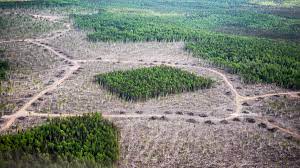
Source: National Audubon Society
- Habitat destruction: Habitat destruction is when a habitat can no longer support the species that exist there, usually because of a major impact on that habitat like mining or deforestation.
- Habitat degradation: Habitat degradation is when a habitat’s ability to support the species that exist there is reduced, but not destroyed completely. This can still have major impacts on the species that live there, including extinction.
- Fragmentation: Fragmentation is when habitats are split up, usually by human activities like building. For example, when a forest is split in two by a road, the habitat is fragmented. Habitat fragmentation reduces the ability of the habitat to support species as it may no longer be large or diverse enough to do so.
Habitat loss is occurring quickly and is not confined to a single type of ecosystem. As of 2022:
- Around half of the world’s forested land has been cleared.
- Only 3% of tallgrass prairies exist in their natural state in North America.
- Around 60-70% of European wetlands have been destroyed and 50% in the U.S.
- Around 20% of coastal areas have been severely modified by humans
Why Is Habitat Loss Occurring?
Habitat loss is occurring around the world for a variety of reasons, many of which are human-caused. These include agriculture, urbanization, resource extraction and environmental changes.
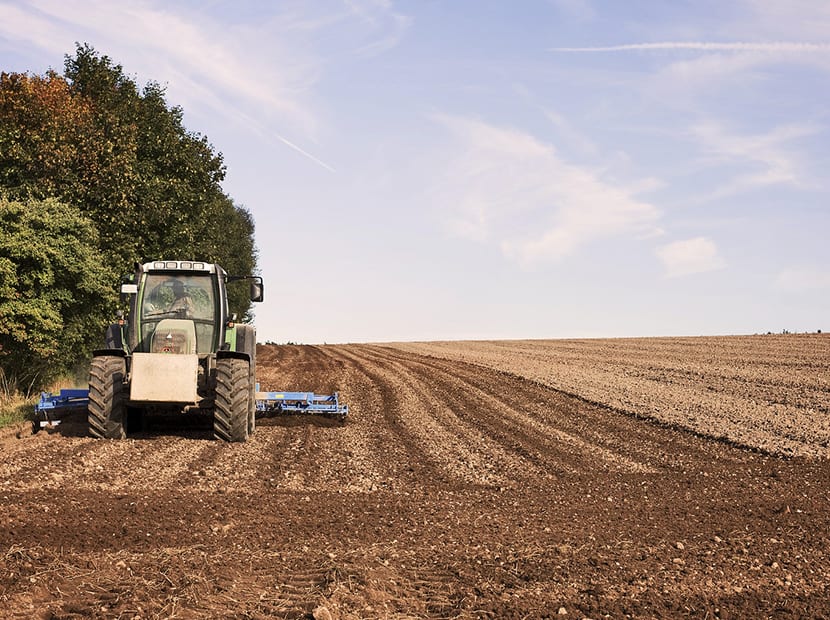
Source: Kerfab
Agriculture: Agriculture is the biggest driver of land-use changes and thus of habitat destruction. Deforestation (the cutting of trees to convert land to other uses) for agriculture peaked in the 80s and 90s, but is still happening today. Agriculture is responsible for 90% of deforestation, with around half of deforestation as a result of conversion to cropland, and 40% as a result of conversion to livestock grazing land.
Deforestation is a problem worldwide, but is particularly threatening to biodiversity when it occurs in the tropics. Many species exist only in the tropics and cannot survive elsewhere when their habitats are destroyed. Between 2000 and 2010, 40% of tropical deforestation was caused by large scale commercial agriculture (mainly cattle, soy, and palm oil production) and another 33% was caused by local subsistence farming.

Urbanization: Urbanization and industrialization are other forms of land-use changes that contribute to habitat destruction. Urbanization is the process of building cities, as well as the process by which more people move to cities from rural areas. Urbanization is highly related to industrialization, the development of industries on a large scale.
Urbanization is a major driver of habitat loss and specifically habitat fragmentation. As buildings or roads are built, not only are natural habitats cleared, but the remaining habitats are fragmented. A 2016 study of urbanization in 16 cities around the world found that urbanization causes habitat loss that increases at the same rate as habitat fragmentation. In other words, when urbanization increases, habitat loss increases, and so does habitat fragmentation. Not only does urbanization destroy habitats, but it can make habitats smaller, which can make it difficult or impossible for some species to get enough resources or find mates. Fragmentation also makes it difficult for species to migrate. For example, a busy road in between two habitats effectively makes it impossible or extremely dangerous for migratory animals to continue.
Urbanization and industrialization also introduce pollutants into the environment which contributes to habitat degradation and habitat loss. These pollutants may kill wildlife directly, or make it difficult to find important nutrients or clean water.
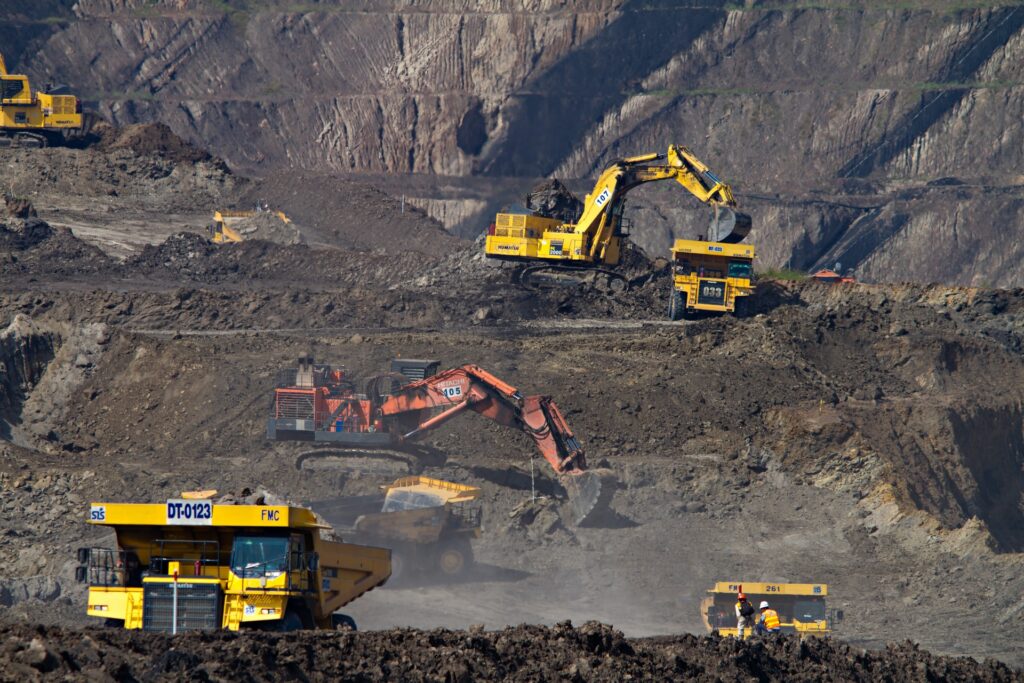
Resource extraction: Taking materials from the environment, such as metals, fossil fuels or even food and water is referred to as resource extraction. Many forms of resource extraction such as mining or logging are major drivers of habitat loss. Mining like coal mining can kill species directly through construction and other mining activities. Resource extraction can also have longer term effects. For example, mining changes the environment permanently, even if the mining is halted in the future. Wildlife suffers as a result of this habitat loss. Mining and fuel extraction can also cause pollution which can harm wildlife and destroy ecosystems.
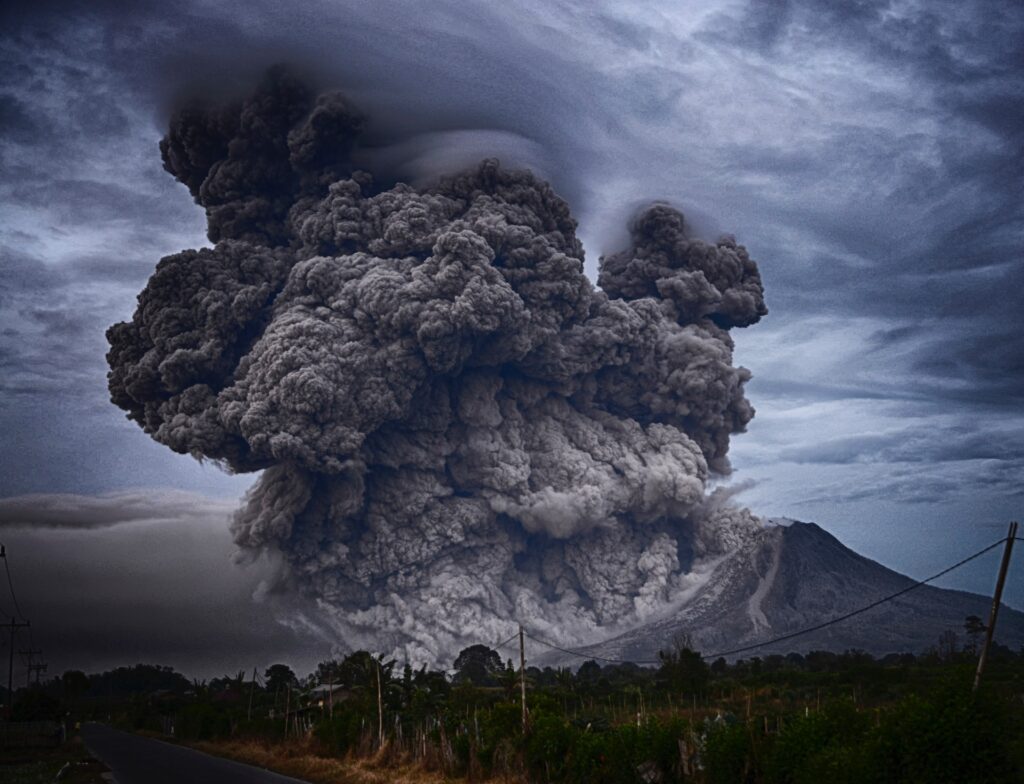
Environmental changes: Finally, natural changes to the environment can cause habitat loss. For example, a major storm, volcanic eruption, or tsunami can destroy a variety of habitats and make it impossible for wildlife to survive in that area. Climate change is another human-caused driver of habitat loss. Increased temperatures, drought and flooding are all examples of climate change related environmental changes that destroy habitats and force species to adapt, find a new habitat, or die.
How Does Habitat Loss Threaten Biodiversity?
Habitat loss has major impacts on the species that live in that habitat and depend on its resources. In fact, habitat loss is a main cause of endangerment for 85% of species on the IUCN’s Red List, a list of endangered or threatened species.
First, habitat loss directly reduces biodiversity by making species’ populations smaller or pushing species to extinction. Smaller populations are also less stable, which leads to further problems. For example, smaller populations resulting from habitat loss also diminishes species’ ability to find mates and reproduce. Some species need a large territory to find mates (and other resources like food). Habitat loss and fragmentation make habitats smaller, making it difficult for some species to find mates. Without a mate, these animals cannot reproduce, which decreases population sizes and ultimately reduces biodiversity.
Habitat loss also reduces species’ genetic diversity, which is a part of biodiversity. Genetic diversity is the range of traits, or characteristics, that exist in a species’ population. For example, in the toucan population, some birds may have longer or larger bills than others, which makes it easier for them to reach food. Higher genetic diversity means higher biodiversity, as there is greater diversity of not only the kinds of organisms that exist, but also of the specific genetic traits that exist (even within a single population). As habitats are destroyed, the species that have characteristics that are helpful in new conditions survive, while the ones that cannot die off. This not only reduces biodiversity, but also reduces the amount of different traits that future populations have, which makes them more vulnerable to further changes in the future.
Finally, habitat loss has impacts throughout the food web and disrupts interactions between species. If habitat destruction reduces the population size of one type of animal, the entire food chain that relies on that species, both as a predator and as a source of food, will shift. These food web imbalances can ultimately lead to extinction through a lack of food resources or over-predation.
Other Threats to Biodiversity
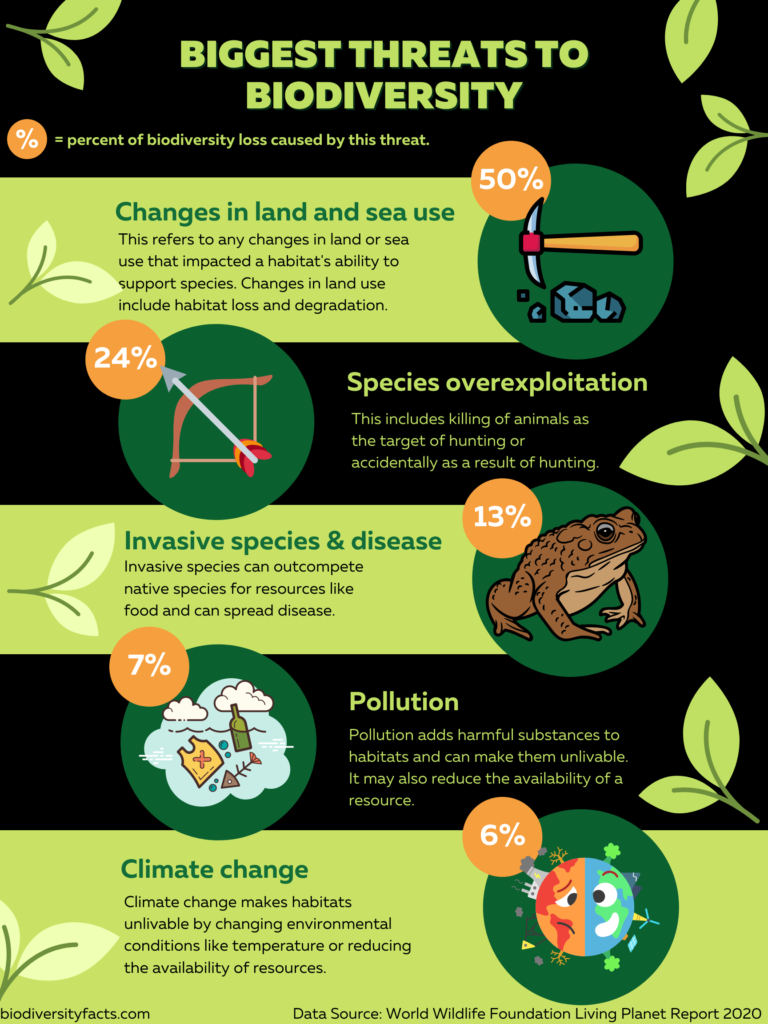
While changes in land use is the greatest threat to biodiversity, there are other factors that threaten biodiversity as well. Many of these threats to biodiversity, such as pollution and climate change, are also a form of habitat loss, as they make the habitat unlivable for many species or reduce the habitat’s resources.
The World Wildlife Foundation’s Living Planet Report 2020 categorized the major threats to biodiversity, finding that the biggest threats to biodiversity are changes in land use (habitat loss), species overexploitation, invasive species and disease, pollution, and climate change.
Species overexploitation
Species overexploitation includes any activities that kill an organism for human use. This includes hunting and fishing, but also includes animals that are killed by accident as a result of those activities, even if that animal is not the target (known in fishing as bycatch). Many of these activities not only kill animals directly, but also push populations to sizes that are too small to be sustained.
For example, humans exploit over 400 different marine species as food. When humans overfish, the amount of fish is depleted, which can lead to problems finding mates and reproducing, leading to further declines in fish populations. Additionally, other species that depend on the overfished species may lack food sources. Overfishing and other forms of overexploitation can lead to extinction.
Invasive species & disease
An invasive species is an organism that is introduced into a non-native habitat. Invasive species can have major impacts on native species as they may outcompete native species for limited resources like growth space in sunlight, in the case of plants, or food, in the case of animals. For example, the invasive plant kudzu can outcompete native plants, leading to their extinction and a less diverse community of plants in that habitat. Invasive species may also change the habitat’s conditions, like soil chemistry, and make it unsuitable for native species.
Invasive species may also spread disease to new environments, as do humans. These diseases are often not present in the habitat previously, and may cause extinctions if native species cannot overcome it.
Invasive species are often transported by humans, either on purpose or accidentally. For example, some invasives are brought accidentally on boats, while others may have been introduced intentionally (often before humans fully understood the consequences).
Not only do invasive species cause biodiversity loss, but this can lead to economic losses as well due to human reliance on a variety of species and other ecosystem services. For example, invasive species can overtake agricultural crops or may cause some seafood species to go extinct. It’s estimated that invasive species cost about $120 billion every year in the U.S.
Pollution
Pollution drives biodiversity loss by killing species directly, through changing the food web, and through reducing the amount of resources that many species rely on. For example, mercury pollution has severe impacts on many already-threatened Arctic species such as polar bears, seals, and orca whales, as it can cause immune problems and cancer. When even one species is affected, the food web as a whole is altered.
Another example of pollution driving biodiversity loss is nutrient runoff into waterways, often caused by agricultural fertilizers. This can cause eutrophication, an overgrowth of aquatic plants that creates a lack of oxygen in the body of water, which kills aquatic organisms.
Climate change
Climate change drives biodiversity loss by changing environmental conditions and creating a lack of crucial resources. By some estimates, climate change (in addition to agriculture) could reduce natural habitats by 23% in the next 80 years. Climate change causes increased temperatures, increased drought, increased flooding, increased wildfires, and increased extreme weather events like hurricanes. All of these impacts destroy ecosystems, or change them in such a way that species are no longer adapted to living there.
For example, increased temperatures in certain habitats changes the types of plants and animals that can thrive there, as many species are adapted to living within certain temperature ranges. If these species cannot adapt or move, they may go extinct.
The graphs below show the major threats to biodiversity by region. While changes in land and sea use is the major driver of biodiversity loss worldwide, the proportion of the threat may be different depending on the region. For example, species overexploitation is a much bigger driver of biodiversity loss in Africa than in other regions.
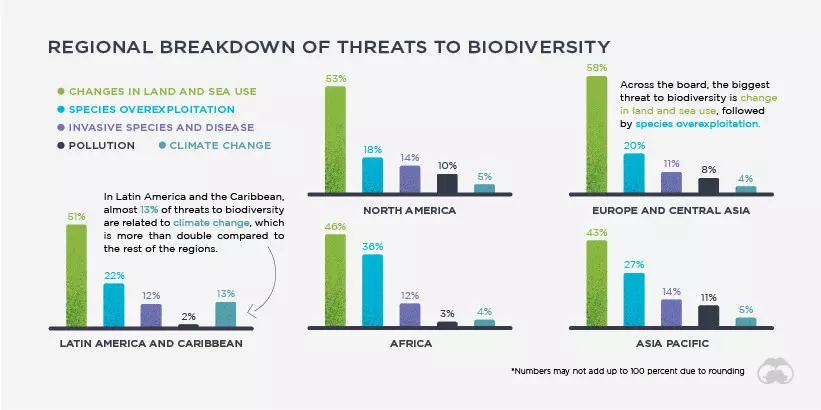
There are several actions we can take to prevent further biodiversity loss. These include government regulation and reduction of invasive species, in addition to overhauling our agriculture system to be less wasteful.
Read more: Solutions to Conserve Biodiversity